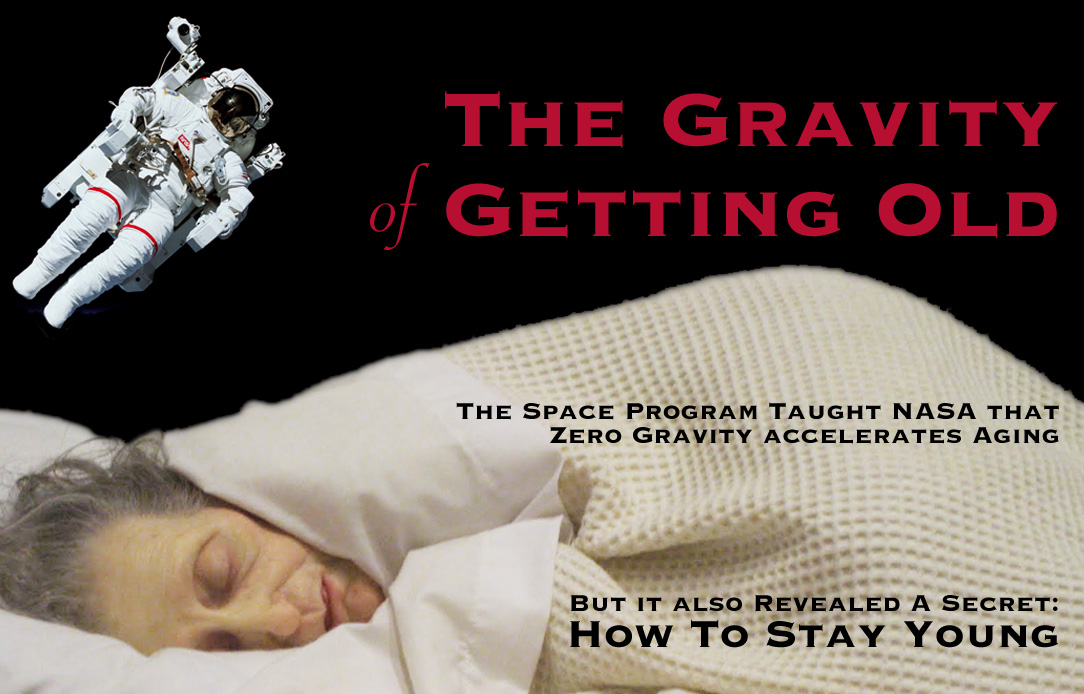

What do weightless space travel and old age have in common? Apparently quite a lot. And NASA has made a discovery that might make both more enjoyable.
We've all seen the movies where astronauts were selected for space travel because they had "the right stuff." Being a skilled pilot was not good enough for the early space programs. Potential astronauts and cosmonauts were put through a grueling program of physical conditioning which selected only the most fit. Each candidate was put through strenuous exercises and exposure to both high G-forces in huge centrifuges and brief periods of weightlessness in special jets [below].
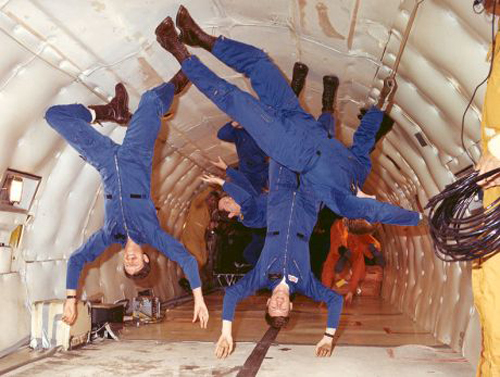
But apparently, even that was not enough.
Returning from brief encounters with zero gravity, astronauts suffered with physical disabilities that took a long time to improve -- and some effects never did go away.
With all the optimistic talk about space tourism and missions to Mars, the crucial factor inhibiting space travel -- weightlessness -- is something that is hardly ever discussed, let alone understood.
Returning US astronauts and Russian cosmonauts report feeling "faint" and have shown difficulties walking and keeping their balance. Many are prone to losing consciousness when standing up. The symptoms are so pronounced that NASA instituted a period of "quarantine" to hide the dibilitating effects from the public.
These disabilities are not just some "space hangover". They last for a long time and the returning astronauts must work hard to get back to normal.
Currently, for every day under 30 days that an astronaut is in zero-gravity space, it takes a whole day on Earth to recover. If the time is over 30 days it takes about 2.5 days to recover. It's a cumulative effect.
Six months in zero-gravity takes about 2 years of recovery time. But if you stay a little longer, 14 months for example, it takes 10 to 20 years to recover to your appropriate age health.
The Soviets (Russians) were first to take note of the problem.
In the early 1960s, Soviet cosmonauts Titov and Nikolayev had trouble with low blood pressure when standing. They were both returning from just 24 hours of weightlessness. Later, after even longer flights, the cosmonauts had to be carried away from their landing sites on stretchers.
The Soviet (Russian) space program was the first to realize the serious obstacle of bad effects from weightlessness on the human body. They pioneered much of the research that has been continued at NASA -- most significantly the use of a 6 degree tilt to the experimental beds of the subjects (explained below).
In this story you will learn what a NASA scientists discovered about the bad effects of zero gravity and how the solution to this dilemma can improve your own life and health here on Earth.
How Zero Gravity Can Kill
Dr. Joan Vernikos was Director of Life Sciences for NASA at the height of the space program and was tasked with understanding what changes were happening in the zero gravity environment of space and how they could be overcome.
Before John Glen orbited Earth back in February of 1962 it was thought that many of the body's organs would fail without gravity. Scientists believed that a person could not swallow or digest food, blood would not circulate and one's eyes would distort their shape or pop out of their sockets. Thankfully, none of these dramatic things happened. But the hidden problems of weightlessness would prove to be just as bad.
Medical analysis showed that returning space travelers who experienced zero-gravity had accelerated muscle wasting and loss of calcium in their bones. The calculated rate of bone density loss was between 1.6% a month and as much as 1% a week. At first, this was believed to be the result of inactivity and a vigorous program of weightless exercise was instituted.
"In spite of strenuous exercise in space, for several hours every day, loss in bone, muscle and cardiovascular function happens ten times faster in space than on Earth. Exercise without gravity is not as effective."-- Dr. Vernikos
Astronauts were made to strap themselves to treadmills, pedal on make-shift bicycles and work out with elastic exercise straps. Blood samples were taken throughout these exercise sessions. Although the benefits were noted during the period of exercise, the negative effects began again as soon as they stopped. Physical exercise is estimated to be only 50% as effective in zero-gravity.
While astronaut's eyes did not pop out as predicted, returning to earth left their eyesight less sharp. Balance was difficult, and for some time they would stand with their feet wide apart. They walked with a shuffle and had great difficulty getting around corners without hitting the wall. Many reported feeling that they were somehow older, beyond their years, and soon their symptoms began to mimic an accelerated aging process.
Dr. Vernikos was among the first to see the similarity between the effects of zero gravity and the aging process. She began to document this association and conducted studies to learn more about these two observations. First, she listed the changes both during zero-gravity and then upon returning to Earth's gravity (1G) [below] .
|
Notable Changes While in Space (Zero Gravity)
* "Moon face"; swollen, no wrinkles, expressionless
|
Symptoms After Returning from space
* Everything feels very heavy
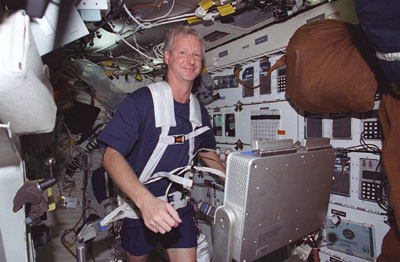 [Above] Astronaut Steven A. Hawley, mission specialist, runs on a treadmill on the Space Station.
|
Next, she drew a comparison between the effects of zero-gravity exposure and old age [below].

Gathering the Evidence
Human anatomy evolved in Earth's (1G) gravity so it is understandable that removing this environmental constant is going to invite problems. Gravity is how things know that they are up or down. Gravity pulls on fluids, of which out bodies are about 80%. Sure, there were going to be bodily changes in zero-gravity and studies needed to be done.
But how can you even study a condition that only a few humans have experienced? Back in the 1980s, there were only about a hundred astronauts and cosmonauts who had experience zero-gravity. Large numbers of subjects would be needed to test various remedies. This was a dilemma.
The old medical journals had something that was interesting. There was some evidence from a prior study where the subjects, although not in space, had shown the same group of symptoms after enduring extreme bed rest for long periods of time.
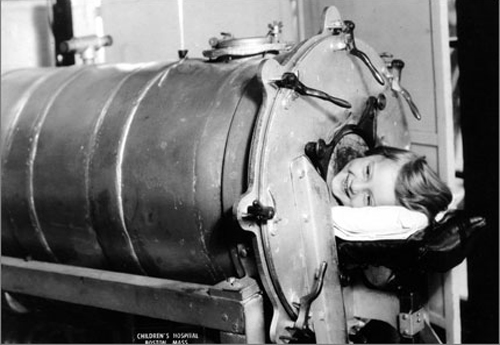
During the polio epidemic in the 1940s, Don Whedon of the National Institute of Health questioned whether the muscle deterioration from polio was related to the virus or had some other cause. He found that confining victims to bed with casts to immobilize their limbs (as was the treatment of the era) caused them to lose calcium in their bones and caused their muscles to deteriorate. [source]
The Russians had already discovered that extreme bedrest was a good way to mimic weightlessness and this made it possible to conduct experiments using large numbers of volunteers who would only have to remain in bed.
"The Soviets had been in space the longest and they too had decided that the best research method was the one using bed-rest. Towards the early 1970s they improved on this method by tilting the bed so that the head was lower than the feet. This was because returning cosmonauts had complained that lying in a horizontal bed after spaceflight made them feel as though they were slipping off the foot of the bed. The angle of tilt at which they felt most comfortable was six degrees. In 1980, I introduced this Soviet model of head-down bed-rest into the US."
--Dr. Vernikos
A Japanese study of 2500 men and woman, all between 25 to 55 years old, was the first study to show that bed rest alone can bring about the symptoms of advanced aging. Subjects were asked to stay in bed from 4 to 84 days. They were not allowed to get up for any reason -- even an in-bed toilet was used. Volunteers had no showers and could have no visitors. [source]
The adverse changes in subjects stamina and health, characterized as advance aging, were seen as directly related to the amount of bed rest they endured.
Proof that these changes in stamina were potentially lethal was suggested by a Finnish study.
Researchers at Finnish Centre for Interdisciplinary Gerontology followed more than 100 adults for 8 years. The subjects were categorized as 1)fully mobile and active, 2)some impairments but were active and 3)impaired and sedentary.
|
NASA Experiments Find the Remedy
Dr. Vernikos was the first to ask the question: If exposure to zero-gravity accelerates aging, and this is similar to lying in bed, what are the similarities and how can we reverse this aging process?
Dr. Vernikos tried many different things to counter the bad effects of extreme bed-rest with her own experiments. She had some bed-ridden subjects get up and vigorously exercise at varying intervals of time. Other subjects simply stood up briefly every half hour or more, then returned to bed. Their physical conditions were always monitored. In the end the solution was surprising yet very simple.
Dr. Vernikos established that optimum health and stamina could be maintained, even during extreme bed rest, if the subjects briefly stood up once every 20 minutes. Compared to other more strenuous physical activities at various time intervals, this simple technique was the most effective.
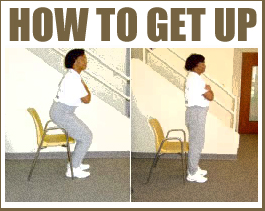 When we change our posture, from lying down or sitting to standing up, we stimulate vascular reflexes that change the diameter of our blood vessels to maintain adequate systemic pressure, especially to our brain. The parts of the body's circulation that were positioned horizontally suddenly become vertical and gravity can rob the brain of its share of blood. It's these reflexes that become disabled in zero-gravity and prolonged bed rest.
When we change our posture, from lying down or sitting to standing up, we stimulate vascular reflexes that change the diameter of our blood vessels to maintain adequate systemic pressure, especially to our brain. The parts of the body's circulation that were positioned horizontally suddenly become vertical and gravity can rob the brain of its share of blood. It's these reflexes that become disabled in zero-gravity and prolonged bed rest.
Getting old, according to Dr. Vernikos, can be viewed as a process whereby we 'give in' to gravity by sitting or lying down more frequently. We tend to prefer less posture changing activities and rely more on modern appliances that keep us comfortably seated or lying in bed. Even the simplest reason to stand up has been taken away in the name of convenience. By doing so, the research shows, we are doing our bodies a dis-service.
Simply put: By standing up often and interrupting our sitting posture, we help ourselves overcome the force of gravity that causes us to age. Dr. Vernikos found that simply standing up at least once every 20 minutes causes good cardiovascular and metabolic changes in your body.
Standing up from a seated position increases an enzyme that transports fat to muscles in your body to be used as fuel. This keeps you young and avoids the pre-mature aging that can come from lessening the beneficial stress from gravity. It counters the ill effects of both zero-gravity and lying in bed.
This simple non-exercise activity almost takes no effort, yet it has been demonstrated to prolong life and maintain independence. It requires no money, no complicated instructions and no precautions. You simply stand up, sit down and wait for another 20 minutes.
At work it may be that getting coffee or using the rest room is enough of a posture change. It should be part of an activity in which you get up from your chair, do something while standing, then sit down again. And if it happens several times an hour you are good.
Q: What about standing desks?
Many people have experimented with standing desks. Dr. Vernikos was not in favor of these as it's the movement of up and down that is more important than standing up for a long period of time.
Also, she warns not to cram all your standing up activity into an hour or two a day. It doesn't work like that. Dr. Vernikos says it only works if you spread it throughout the day. It has to become a habit such that we never sit still or lay down for very long in order to get the effect of delayed aging and loss of flexibility and movement.
She likes to tell her audience that standing up every 20 minutes should become a habit and that it takes just 8 weeks to establish. Dr. Vernikos tells of visits to nursing homes where implementing this technique has meant patients could walk again and were more independent. She highly recommends this as a health routine for all ages, in space and on Earth.
Dr. Vernikos uses the term "non-exercise activity" to describe these posture changes. There is usually no aerobic activity involved -- nothing strenuous. You just stand up, maybe move your arms around a bit (they also benefit from changes relative to gravity), then you can return to sitting or lying in bed again. Once every 20 minutes is apparently all it takes to keep the aging process from robbing you of life, although even hourly seems to also offer some benefits.
How to Keep Young and Live Longer
According to Dr. Vernikos, we have all felt the sluggish impact of brief periods of bed rest when we have had a cold or suffered an injury that made us immobilized. The foggy, out-if-it feeling we associated with the flu was actually the result of the time spent in bed. It was, in effect, our zero-gravity time.
Gravity is quite strong, but little understood. The Moon, for example, is 240,000 miles away yet it pulls the tides of our oceans. To escape the gravity of Earth, a vehicle must speed up to 25,000 mph. Earth's gravity is called 1G. Some jet pilots can experience 5 or 6 times the regular gravity -- called 5G or 6G.
Erasmus Darwin, related to Charles Darwin, proposed hyper-gravity to treat fever, reduce heart rate, induce sleep... It was even proposed for treatment for the mentally ill in the 19th century. Modern centrifuges can go 20G although few can endure more than 10G for few seconds.
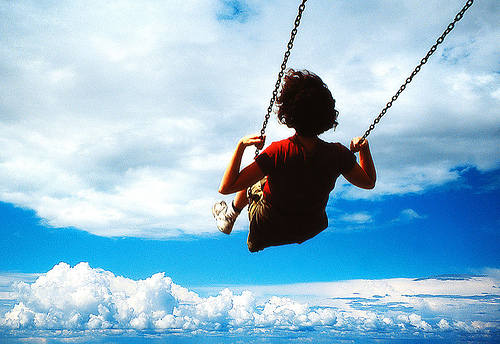
It is ironic that the activities which we prefer in our youth are frequently associated with stimulating this gravity posture change. Swinging on a backyard swing or sliding down... using the jungle gym or the see-saw... they are all manipulating the force of gravity on our bodies, keeping those reflexive circuits working.
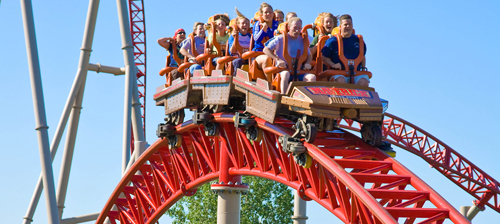
This activity can continue to adulthood where roller-coasters, speeding motorbikes or jumping off high bridges with a tether bring thrills that most of us would rather not experience. It's much safer to practice standing up now and then.
What About Mars?
In the Star Trek movies the space ship they are on has artificial gravity. Although this is great in reducing the ill effects of weightlessness, space travelers would be wise to follow Dr. Vernikos' stand up method keep their health and stamina.
If passengers on future space flights experience artificial gravity, they will still suffer from immobility and excessive bed rest symptoms. If they are in some type of hibernation then a mechanical change of posture would have to be built in to the storage bed. Gravity pressure must be experienced to maintain health.
A Mars bound flight with micro-gravity or zero-gravity for as many as 6 months would almost certainly result in incapacitated astronauts who would require years to fully recover. They would suffer fatigue and the very real danger of bone fracture and intermittent loss of consciousness. The entire mission would be in jeopardy.
Mars has 0.38G -- about a third of Earth's gravitational pull -- and so maintaining a healthy stamina would be a concern even if the flight there was not destructive enough.
Mars mission lengths are determined largely by where each planet -- Earth and Mars -- is positioned relative to their orbit around the Sun. A so-called Conjunction Class mission requires slow transit speed and a 500 day stay on the red planet so that Earth can be repositioned for another rendez-vous.
Opposition Class missions use a faster rocket accelerated trip to the planet but leave only a window of perhaps 30 to 45 days on the Mars surface. This would require only 430 days. Loss of gravity is just part of the many problems we need to solve before space travel is safe and worth the risk. No doubt, some type of mechanical solution will be found that enables long duration space flight. A hint of a possible solution is described by Dr. Bosco [1], a pioneer of Whole Body Vibration research:
"Gravity normally provides the major portion of the mechanical stimulus responsible for the development of muscle n everyday life and training. It should be remembered, that specific programs for strength and power employ exercises with fast, abrupt variations of G-force. Therefore, simulation of hypergravity (wearing vests with extra loads) has been utilised for improving explosive muscle power. On the other hand, changes of gravitational conditions can be produced also by mechanical vibrations applied to the whole body."-- source
Some other interesting ideas are to use a vacuum chamber -- very similar to the iron lung machines used in the polio outbreak of the 40s. The effect is to draw blood in the extremities and simulate the effect of gravity when one stands up [pictured below].
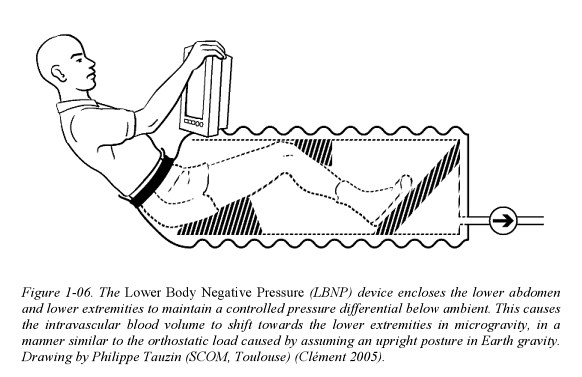
This device, the Lower Body Negative Pressure (LBNP) system has been tried on the Space Station to re-condition orthostatic reflexes when a Space Station resident is nearing his return to Earth. When it is first used, the astronaut often feels lightheaded, which is similar to what would happen on Earth. The negative pressure is minor at first and varied over time to condition the astronaut to the experienced at 1G.
One of the problems with the LBNP system is that every astronaut seems to have a different and unique pattern of reconditioning, some quicker than others, so no routine program has yet been established.[8]
While the solution for zero-gravity and space travel remains unclaimed, here on Earth we can use this stand up technique to preserve our health and avoid advanced aging that comes from giving in to gravity.
So get up, stand up!
Stand up for your life!
|
Notes:
(1) Bosco C, Cardinale M, Tsarpela O, et al. The influence of whole body vibration on jumping performance. Biology of Sport. 1998;15(3):157-164. (2) Inactivity: Physiological Effects, Edited by H. Sandler and J. Vernikos. (source) (3) Effects of exposure to simulated microgravity on neuronal catechplamine release and blood pressure response to norepinephrine and angiotensin, Victor A. Convertino, David A. Ludwig, Brian D. Gray, Joan Vernikos, Clinical Autonomic Research 1998, 8:101-110. (4) Hirvensalo, M., Rantanen, T., Heikkinen, E., "Mobility difficulties and physical acidity as predictors of mortality and loss of independence in the community-living older population." J Americ Geriatric Soc 48 (5):393-498, 2000. (5) The G-Connection: Harness Gravity and Reverse Aging, Dr. Joan Vernikos (book) (6) Human Exploration of Space: why, where, what for? by Dr. Joan Vernikos [,source book) (7) Head-down bed rest impairs vagal baroreflex responses and provokes orthostatic hypotension, (source journal) (8) Artificial Gravity, edited by Gilles Clément, Angelia P. Bukley, [book |

Reader's Comments
Great Article... very useful information... wish they taught such things in our School Health Class...and gave a mini-trampoline to all the kids, to take home so their Parents could also use them...There has been a lot of studies done on the anti-gravity affects "while in the air" of a trampoline...I have used a mini since the early 80's and have reaped some fantastic results... Thanks for you interest in matters of "Up in the Air".
L
From Wikipedia, the free encyclopedia
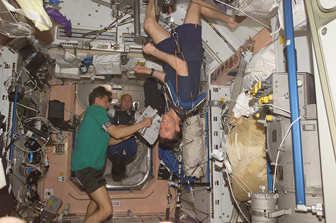
Weightlessness, or an absence of 'weight', is in fact an absence of stress and strain resulting from externally applied forces, typically contact forces from floors, seats, beds, scales, and the like. Counterintuitively, a uniform gravitational field does not by itself cause stress or strain, and a body in free fall in such an environment experiences no g-force acceleration and feels weightless. This is also termed zero-g.
When bodies are acted upon by non-gravitational forces, as in a centrifuge, a rotating space station, or within a space ship with rockets firing, a sensation of weight is produced, as the forces overcome the body's inertia. In such cases, a sensation of weight, in the sense of a state of stress can occur, even if the gravitational field were zero. In such cases, g-forces are felt, and bodies are not weightless.
When the gravitational field is non-uniform, a body in free fall suffers tidal effects and is not stress-free. Near a black hole, such tidal effects can be very strong. In the case of the Earth, the effects are minor, especially on objects of relatively small dimension (such as the human body or a spacecraft) and the overall sensation of weightlessness in these cases is preserved. This condition is known as microgravity and it prevails in orbiting spacecraft.
A common misconception
A common conception about spacecraft orbiting the earth is that they are operating in a gravity free environment. Although there is a way of making sense of this within the physics of Einstein's general relativity, within Newtonian physics, this is technically inaccurate.
A geosynchronous satellite above a marked spot on the Equator. An observer on the marked spot will see the satellite remain directly overhead unlike the other heavenly objects which sweep across the sky.
Spacecraft are held in orbit by the gravity of the planet which they are orbiting. In Newtonian physics, the sensation of weightlessness experienced by astronauts is not the result of there being zero gravitational acceleration (as seen from the Earth), but of there being no g-force that an astronaut can feel because of the free-fall condition, and also there being zero difference between the acceleration of the spacecraft and the acceleration of the astronaut. Space journalist James Oberg explains the phenomenon this way:
The myth that satellites remain in orbit because they have "escaped Earth's gravity" is perpetuated further (and falsely) by almost universal misuse of the word "zero gravity" to describe the free-falling conditions aboard orbiting space vehicles. Of course, this isn't true; gravity still exists in space. It keeps satellites from flying straight off into interstellar emptiness. What's missing is "weight", the resistance of gravitational attraction by an anchored structure or a counterforce. Satellites stay in space because of their tremendous horizontal speed, which allows them -- while being unavoidably pulled toward Earth by gravity -- to fall "over the horizon." The ground's curved withdrawal along the Earth's round surface offsets the satellites' fall toward the ground. Speed, not position or lack of gravity, keeps satellites in orbit around the earth.
A geostationary satellite is of special interest in this context. Unlike other objects in the sky which rise and set, an object in a geostationary orbit appears motionless in the sky, apparently defying gravity. In fact, it is in a circular equatorial orbit with a period of one day.